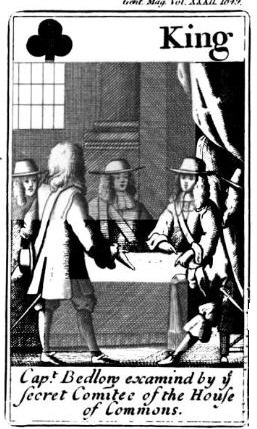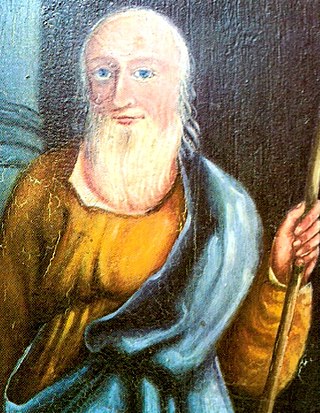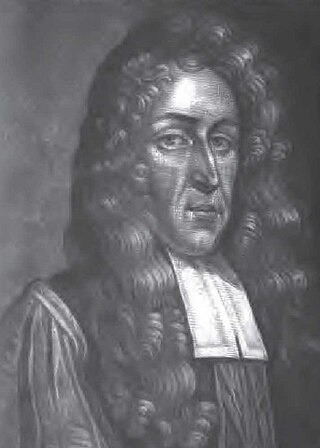Related Research Articles

Titus Oates was an English priest who fabricated the "Popish Plot", a supposed Catholic conspiracy to kill King Charles II.

The Popish Plot was a fictitious conspiracy invented by Titus Oates that between 1678 and 1681 gripped the Kingdoms of England and Scotland in anti-Catholic hysteria. Oates alleged that there was an extensive Catholic conspiracy to assassinate Charles II, accusations that led to the executions of at least 22 men and precipitated the Exclusion Bill Crisis. During this tumultuous period, Oates weaved an intricate web of accusations, fueling public fears and paranoia. However, as time went on, the lack of substantial evidence and inconsistencies in Oates's testimony began to unravel the plot. Eventually, Oates himself was arrested and convicted for perjury, exposing the fabricated nature of the conspiracy.

Sir Edmund Berry Godfrey was an English magistrate whose mysterious death caused anti-Catholic uproar in England. Contemporary documents also spell the name Edmundbury Godfrey.

William Bedloe was an English fraudster and Popish Plot informer.
Thomas Hickman-Windsor, 1st Earl of Plymouth, PC, was the son of Dixie Hickman and his wife Elizabeth Windsor, sister and heiress of Thomas Windsor, 6th Baron Windsor. He assumed the additional surname of Windsor and succeeded to the Windsor family's estate around Hewell Grange near Redditch in 1645. The same year he distinguished himself in the Battle of Naseby. Hickman-Windsor impressed King Charles I by relieving his garrison at High Ercall.

William Howard, 1st Viscount Stafford, FRS was the youngest son of Thomas Howard, 21st Earl of Arundel, and his wife, the former Alethea Talbot. A Fellow of the Royal Society from 1665, he was a Royalist supporter before being falsely implicated by Titus Oates in the later discredited "Popish Plot", and executed for treason. He was beatified as a Catholic martyr by Pope Pius XI in 1929.

Sir George Wakeman was an English doctor, who was royal physician to Catherine of Braganza, Consort of Charles II of England. In 1678, in the allegations of the fabricated Popish Plot, he was falsely accused of treason by Titus Oates, who had gained the backing of Thomas Osborne, 1st Earl of Danby, the effective head of the English government. Oates accused Wakeman of conspiring to kill the King with the help of the Jesuits, and to put his brother James, Duke of York on the throne in his place. At his trial in 1679 Wakeman was acquitted, the first sign that the public was beginning to lose faith in the reality of the Plot.
Events from the year 1678 in England.
Miles Prance was an English Roman Catholic craftsman who was caught up in and perjured himself during the Popish Plot and the resulting anti-Catholic hysteria in London during the reign of Charles II.
William Petre, 4th Baron Petre was an English peer and victim of the Popish Plot.

Nicholas Postgate was an English Catholic priest who was executed for treason on the Knavesmire in York on 6 August 1679 as part of the anti-Catholic persecution that was sweeping England at that time. He is one of the 85 English Catholic Martyrs of England and Wales beatified by Pope John Paul II in November 1987.

Elizabeth Cellier, commonly known as the "Popish Midwife", was a notable Catholic midwife in seventeenth-century England. She stood trial for treason in 1679 for her alleged part in the "Meal-Tub Plot" against the future King James II, but was eventually freed. Cellier was later imprisoned for allegations made in her 1680 work Malice Defeated, in which she recounted the events of the alleged conspiracy against the future King. She later became a pamphleteer and advocated for advancements in the field of midwifery. Cellier published A Scheme for the Foundation of a Royal Hospital in 1687, where she outlined plans for a hospital and a college for instructions in midwifery, as well as proposing that midwives of London should enter into a corporation and use their fees to establish parish houses where any woman could give birth. Cellier resided in London, England until her death.
Maurus Corker was an English Benedictine who was falsely accused and imprisoned as a result of the fabricated Popish Plot, but was acquitted of treason and eventually released.

Richard Langhorne was an English barrister and Catholic martyr, who was executed on a false charge of treason as part of the fabricated Popish Plot. He fell under suspicion because he was a Roman Catholic and because he had acted as legal adviser to the Jesuits at a time of acute anti-Catholic hysteria.

Edward Colman or Coleman was an English Catholic courtier under Charles II of England. He was hanged, drawn and quartered on a treason charge, having been implicated by Titus Oates in his false accusations concerning a Popish Plot. He is a Catholic martyr, beatified by Pope Pius XI in 1929.

Thomas Whitbread was an English Jesuit missionary and martyr, wrongly convicted of conspiracy to murder Charles II of England and hanged during the Popish Plot. He was beatified in 1929 by Pope Pius XI and his feast day is celebrated on 20 June.
Stephen Dugdale (1640?-1683) was an English informer, and self-proclaimed discoverer of parts of the Popish Plot. He perjured himself on numerous occasions, giving false testimony which led to the conviction and execution of numerous innocent men, notably the Catholic nobleman Lord Stafford, the Jesuit Provincial Thomas Whitbread, and the prominent barrister Richard Langhorne.
Lionel Anderson, alias Munson was an English Dominican priest, who was falsely accused of treason during the Popish Plot, which was the fabrication of the notorious anti-Catholic informer Titus Oates. He was convicted of treason on the technical ground that he had acted as a Catholic priest within England, contrary to an Elizabethan statute, but was reprieved from the customary death sentence. He was eventually released and sent into exile, after a biased trial, and after serving a term of imprisonment.

John Gavan was an English Jesuit. He was a victim of the fabricated Popish Plot, and was wrongfully executed for conspiracy to murder King Charles II. He was beatified in 1929 by Pope Pius XI.

Anthony Turner was an English Jesuit priest and martyr. He was a victim of the Popish Plot, and was falsely convicted and executed for conspiracy to murder Charles II. He was beatified in 1929 by Pope Pius XI and his feast day is 20 June.
References
- 1 2 3 4 5 6 Marshall, Alan (September 2004). "Tonge, Israel (1621–1680)" . Oxford Dictionary of National Biography (online ed.). Oxford University Press. doi:10.1093/ref:odnb/27535. ISBN 978-0-19-861412-8 . Retrieved 12 March 2013.(Subscription or UK public library membership required.)
- ↑ "Hartlib Papers". 20 June 1659. Retrieved 10 May 2015.
- ↑ Pollock, John (1903). The Popish plot; a study in the history of the reign of Charles II. Gerald Duckworth and Company. p. 9.
- 1 2 3 4 5 6 7 Kenyon, J. P. (2000). The Popish Plot (2nd ed.). London: Phoenix Press. ISBN 9781842121689.